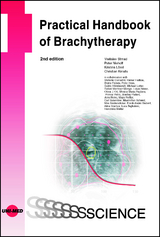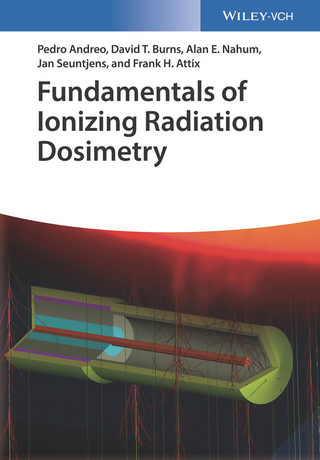Practical Handbook of Brachytherapy
UNI-MED (Verlag)
978-3-8374-1647-3 (ISBN)
- Titel z.Zt. nicht lieferbar
- Versandkostenfrei innerhalb Deutschlands
- Auch auf Rechnung
- Verfügbarkeit in der Filiale vor Ort prüfen
- Artikel merken
The incorporation of advanced image-guiding procedures and the establishment of new applicators allow for the highly accurate implantation of complex implants. 3D-guided real-time adaptive brachytherapy is becoming the newest clinical standard. We now find ourselves in an exciting “new era” of brachytherapy.
The current edition of this textbook has been updated to include all these new developments in brachytherapy, including the results of recent clinical trials and updates to the brachytherapy guidelines by the European Brachytherapy Group within ESTRO (GEC-ESTRO).
A number of highly experienced authors and skilled colleagues from all over Europe have contributed to this edition to educate and inspire all members of the radiation oncology team to utilise the full potential of brachytherapy to the benefit of their patients.
1.Introduction21
2.History of brachytherapy22
3.Physical aspects – sources, dosimetry and dose specification28
3.1.Sources28
3.1.1.Radionuclides in brachytherapy28
3.1.1.1.Gamma and characteristic X-ray radiation28
3.1.1.2.Beta-emitters29
3.1.2.Characterisation of source strength29
3.2.Dosimetry29
3.2.1.Control of reference air kerma rate29
3.2.1.1.Measurement with well-type ionisation chambers29
3.2.1.2.Measurement in compact chambers in solid body phantoms29
3.2.2.Checking the source position30
3.2.3.Calculation of dose distributions30
3.2.3.1.Dose distributions of single sources30
3.2.3.2.Applicator reconstruction31
3.2.4.Optimisation and visualisation of dose distributions33
4.Quality assurance38
4.1.Quality assurance for afterloading devices and procedures in case of emergency for a
remote afterloader38
4.2.Quality assurance in brachytherapy treatment planning systems41
4.3.Special methods41
5.Dosimetrical aspects – dose specifications, dose-volume definitions,
EQD2 concept46
5.1.Dose specification in general46
5.2.Dose specification in intraluminal and intracavitary therapy47
5.2.1.Source positions along one straight line (e.g. vaginal cylinder, oesophageal/bronchial
applicators, vessels)47
5.2.2.Advanced cervical carcinoma48
5.2.3.Endometrial carcinoma not treated surgically48
5.3.Dose specification in interstitial brachytherapy48
5.3.1.Point based systems48
5.3.2.Dose and volume relations, Dose-volume histograms (DVH) and quality parameters (indices)50
5.3.2.1.Relevant dose values and volumes50
5.3.2.2.Quality parameters – QI indices51
5.4.Dose fractionation, combination with external beam and the EQD2 concept53
6.Clinical treatment planning and imaging56
6.1.Clinical treatment planning56
6.1.1.Indication56
6.1.1.1.Definitive treatment56
6.1.1.2.Adjuvant therapy56
6.1.2.Gross Target Volume (GTV) and Clinical Target Volume (CTV)56
6.1.3.Selection of technique, preliminary and definitive treatment plan57
6.1.3.1.Interstitial brachytherapy57
6.1.3.2.Intracavitary brachytherapy60
6.1.3.3.Intraluminal brachytherapy60
6.1.4.Dose, dose fractionation, dose rate60
6.1.5.Infrastructure and personnel planning61
6.2.Modern imaging techniques in brachytherapy62
6.2.1.Basics of image-guided brachytherapy62
6.2.2.Image-guided preliminary treatment planning64
6.2.3.Image-guided application64
6.2.4.Image-guided definitive treatment planning65
6.2.5.Imaging techniques in brachytherapy66
6.2.5.1.CT imaging66
6.2.5.2.MR imaging67
6.2.5.3.US imaging67
7.Instruments and equipment69
7.1.Instruments for interstitial brachytherapy69
7.1.1.Temporary implants69
7.1.1.1.Needles, catheters69
7.1.1.2.Templates71
7.1.1.3.Auxiliary instruments73
7.1.2.Permanent implants74
7.2.Instruments for intracavitary brachytherapy75
7.2.1.Uterovaginal applicators75
7.2.2.Vaginal applicators76
7.2.3.Endometrial applicators77
7.2.4.Intraluminal applicators for tumours in the oesophagus, bronchus, trachea, common bile duct
and nasopharynx and for intravascular brachytherapy77
7.2.5.Moulds for cancers of the paranasal sinuses or orbit78
7.3.Surface applicators78
7.3.1.Skin applicators78
7.3.2.Eye applicators79
7.4.Afterloading devices79
7.4.1.The irradiation device80
7.4.2.The control unit81
7.4.3.Important requirements for radiation protection81
8.Intra- and perioperative brachytherapy82
8.1.Introduction82
8.2.Indications and patient selection criteria83
8.2.1.Intraoperative brachytherapy83
8.2.2.Perioperative brachytherapy84
8.3.Practical execution and technique, practical tips85
8.4.Treatment planning87
8.4.1.Target volumes, dose specification and dose, QA87
8.5.Results88
8.6.Side effects89
8.6.1.Short-term toxicity89
8.6.2.Long-term toxicity89
8.7.Summary90
9.Interstitial hyperthermia91
9.1.Techniques of interstitial hyperthermia91
9.2.Planning, performance and documentation of interstitial hyperthermia91
9.3.Quality and effectiveness of hyperthermia92
9.4.Treatment results in interstitial brachytherapy and hyperthermia92
9.4.1.Glioblastoma92
9.4.2.Local and locoregional recurrences of head and neck cancer93
9.4.3.Breast cancer94
9.4.4.Tumours of the small pelvis94
9.4.5.Prostate cancer94
9.6.Summary95
10.Pre- and postoperative supportive care in brachytherapy97
10.1.Patient preparation97
10.2.Anaesthesia and patient positioning97
10.3.Pain management98
10.4.Anti-infective therapy98
10.5.Prophylaxis of thrombosis99
10.6.Pre- and postoperative supportive care by specific tumour sites99
10.6.1.Head and neck cancer99
10.6.2.Breast cancer100
10.6.3.Prostate cancer100
10.6.4.Gynaecological tumours101
10.7.Follow-up102
11.Cervical cancer103
11.1.Indications103
11.2.Brachytherapy pre-planning103
11.2.1.Brachytherapy target volumes103
11.2.2.Organs at risk105
11.2.3.Dose optimisation105
11.2.4.Dose, dose rate, fractionation112
11.3.Technique of applicator insertion112
11.4.Results113
11.4.1.Concomitant chemoradiotherapy113
11.5.Side effects114
11.6.Summary114
12.Endometrial carcinoma117
12.1.Indications, patient selection criteria117
12.1.1.Current Indications for adjuvant radiotherapy, including Brachytherapy117
12.1.1.1.Low risk endometrial cancer117
12.1.1.2.Intermediate risk endometrial cancer117
12.1.1.3.High to intermediate risk endometrial cancer118
12.1.1.4.High risk endometrial cancer118
12.1.1.5.Adjuvant intravaginal brachytherapy119
12.1.2.Brachytherapy in primary endometrial carcinoma119
12.1.3.Intracavitary and interstitial brachytherapy for recurrences119
12.2.Treatment planning120
12.2.1.Target volumes120
12.2.1.1.Adjuvant intracavitary brachytherapy120
12.2.1.2.Primary brachytherapy121
12.2.1.3.Interstitial brachytherapy in recurrent disease122
12.2.2.Dose specification122
12.2.2.1.Adjuvant brachytherapy122
12.2.2.2.Primary brachytherapy123
12.2.2.3.Interstitial brachytherapy123
12.2.3.Dose, dose rate, fractionation123
12.3.Practical execution and technique124
12.3.1.Adjuvant brachytherapy124
12.3.2.Primary brachytherapy124
12.3.3.Interstitial brachytherapy124
12.4.Results125
12.5.Side effects125
12.6.Summary126
13.Primary vaginal carcinoma128
13.1.Indications128
13.2.Brachytherapy pre-planning128
13.2.1.Target volume128
13.2.2.Organs at risk130
13.2.3.Dose planning130
13.2.4.Dose, dose rate and fractionation131
13.2.4.1.Planning aims for the target volumes131
13.2.4.2.Dose constraints for the organs at risk132
13.3.Practical execution and technique132
13.4.Results133
13.5.Side effects133
13.6.Summary134
14.Vulvar carcinoma135
14.1.Indications, patient selection criteria136
14.2.Treatment planning136
14.2.1.Target volumes136
14.2.2.Dose specification137
14.2.3.Dose, dose rate, fractionation138
14.3.Practical execution and technique138
14.4.Results140
14.5.Side effects140
14.6.Summary141
15.Carcinoma of the female urethra142
15.1.Indications, patient selection criteria142
15.2.Treatment planning142
15.2.1.Target volumes142
15.2.2.Dose specification142
15.2.3.Dose, dose rate, fractionation143
15.3.Practical execution and technique143
15.4.Results144
15.5.Side effects144
15.6.Summary145
16.Carcinoma of the prostate146
16.1.Indications, patient selection criteria147
16.1.1.Permanent brachytherapy with J-125 seeds147
16.1.2.Temporary brachytherapy with Ir-192147
16.1.3.Contraindications to brachytherapy147
16.2.Treatment planning147
16.2.1.Target volumes and organs at risk147
16.2.2.Isotope, dose specification and fractionation148
16.2.2.1.Permanent brachytherapy with J-125 , Pd-103148
16.2.2.2.Temporary brachytherapy with Ir-192148
16.3.Practical execution and technique149
16.3.1.Permanent brachytherapy (seeds)150
16.3.2.Temporary brachytherapy151
16.4.Results154
16.4.1.Permanent brachytherapy (seeds)154
16.4.2.Temporary brachytherapy (HDR)154
16.4.3.Salvage brachytherapy as re-irradiation155
16.5.Side effects155
16.5.1.Permanent brachytherapy (seeds)155
16.5.2.Temporary brachytherapy (HDR)155
16.6.Summary156
17.Carcinoma of the penis159
17.1.Indications, patient selection criteria159
17.2.Treatment planning159
17.3.Practical execution and technique159
17.3.1.Surface mould brachytherapy159
17.3.2.Interstitial brachytherapy160
17.4.Results163
17.5.Side effects163
17.5.1.Early side effects163
17.5.2.Late side effects163
17.6.Summary164
18.Bladder cancer165
18.1.Indications165
18.2.Treatment planning165
18.3.Dose specification166
18.4.Dose, dose rate and fractionation167
18.5.Practical execution and technique167
18.6.Results167
18.7.Side effects168
18.8.Summary168
19.Head and neck tumours170
19.1.Carcinoma of the lip170
19.1.1.Indications, patient selection criteria170
19.1.2.Treatment planning170
19.1.2.1.Target volumes170
19.1.2.2.Dose specification170
19.1.2.3.Dose, dose rate, fractionation172
19.1.3.Practical execution, technique172
19.1.4.Results172
19.1.5.Side effects172
19.2.Oral cavity: carcinoma of the floor of the mouth, carcinoma of the mobile tongue172
19.2.1.Indications, patient selection criteria172
19.2.2.Treatment planning174
19.2.2.1.Target volumes174
19.2.2.2.Dose specification175
19.2.2.3.Dose, dose rate, fractionation175
19.2.3.Practical execution, technique175
19.2.4.Results177
19.2.5.Side effects178
19.3.Oropharynx178
19.3.1.Indications, patient selection criteria178
19.3.2.Treatment planning178
19.3.2.1.Target volumes178
19.3.2.2.Dose specification178
19.3.2.3.Dose, dose rate, fractionation178
19.3.3.Practical execution, technique179
19.3.4.Results182
19.3.5.Complications182
19.4.Buccal mucosa182
19.4.1.Indications, patient selection criteria182
19.4.2.Treatment planning182
19.4.2.1.Target volumes182
19.4.2.2.Dose specification182
19.4.2.3.Dose, dose rate, fractionation182
19.4.3.Practical execution and technique183
19.4.4.Results183
19.4.5.Side effects183
19.5.Nasopharynx183
19.5.1.Indications, patient selection criteria183
19.5.2.Treatment planning183
19.5.2.1.Target volumes183
19.5.2.2.Dose specification183
19.5.2.3.Dose, dose rate, fractionation183
19.5.3.Practical execution, technique184
19.5.4.Results184
19.5.5.Side effects186
19.6.Nasal cancer186
19.6.1.Indications, patient selection criteria186
19.6.2.Treatment planning186
19.6.2.1.Target volumes186
19.6.2.2.Dose specification186
19.6.2.3.Dose, dose rate, fractionation186
19.6.3.Practical execution, technique186
19.6.4.Results188
19.6.5.Side effects188
19.7.Summary188
20.Breast cancer191
20.1.Indications, patient selection criteria191
20.1.1.Interstitial brachytherapy as boost191
20.1.2.Partial breast irradiation with interstitial multicatheter brachytherapy alone191
20.1.3.Postoperative surface/interstitial brachytherapy of the chest wall after chest wall recurrence in
patients who have previously had radiotherapy193
20.2.Treatment planning193
20.2.1.Target volumes193
20.2.1.1.Interstitial brachytherapy193
20.2.1.2.Target volume in surface brachytherapy199
20.2.1.3.Target volume in interstitial brachytherapy for the chest wall199
20.2.2.Dose specification199
20.2.2.1.Interstitial brachytherapy199
20.2.2.2.Surface brachytherapy200
20.2.2.3.Interstitial brachytherapy chest wall200
20.2.3.Dose, dose rate, fractionation200
20.3.Practical execution and technique201
20.3.1.Interstitial brachytherapy201
20.3.2.Mould (surface brachytherapy)204
20.3.3.Interstitial brachytherapy of the chest wall204
20.4.Results204
20.4.1.Boost204
20.4.2.Interstitial brachytherapy alone205
20.4.3.Surface radiotherapy of the chest wall as re-irradiation205
20.5.Side effects205
20.5.1.Boost206
20.5.2.Interstitial brachytherapy alone as APBI206
20.5.3.Surface salvage-brachytherapy as re-irradiation206
20.6.Summary206
21.Lung cancer210
21.1.Indications, patient selection criteria210
21.1.1.Curative endobronchial brachytherapy210
21.1.2.Palliative endobronchial brachytherapy211
21.1.3.Curative endobronchial brachytherapy combined with external beam radiotherapy211
21.1.4.Palliative endobronchial brachytherapy in combination with external beam radiotherapy211
21.2.Treatment planning212
21.2.1.Target volumes212
21.2.1.1.The target volume for a curative intention212
21.2.1.2.The target volume for a palliative intention212
21.2.2.Dose specification212
21.2.2.1.The dose specification for a curative intention212
21.2.2.2.The dose specification for a palliative intention213
21.2.3.Dose, dose rate, fractionation213
21.3.Practical execution and technique214
21.4.Results215
21.4.1.Results of endobronchial HDR or LDR brachytherapy alone in curative intention215
21.4.2.Results of combined external beam and endobronchial radiotherapy in curative intention215
21.4.3.Results of endobronchial HDR or LDR brachytherapy alone in palliative intention215
21.4.4.Results of combined external beam and endobronchial radiotherapy in palliative intention216
21.5.Side effects216
21.6.Interstitial and intraoperative brachytherapy – indication, technique, results218
21.7.Summary219
22.Oesophageal carcinoma222
22.1.Indications, patient selection222
22.2.Treatment planning222
22.2.1.Target volumes222
22.2.2.Dose specification224
22.2.3.Dose, dose rate, fractionation225
22.3.Practical execution and technique225
22.4.Results226
22.5.Side effects227
22.6.Summary228
23.Carcinoma of the anal canal230
23.1.Indications, patient selection criteria230
23.2.Treatment planning230
23.2.1.Target volumes231
23.2.2.Dose specification231
23.2.3.Dose, dose rate, fractionation231
23.3.Practical execution and technique232
23.4.Results and side effects233
23.5.Side effects234
23.6.Summary235
24.Skin tumours237
24.1.Indications, patient selection criteria237
24.2.Treatment planning237
24.2.1.Target volumes238
24.2.2.Dose specification238
24.2.3.Dose, dose rate, fractionation238
24.3.Practical execution and technique238
24.4.Results241
24.5.Side effects242
24.6.Summary242
25.Uveal choroidal melanomas244
25.1.Indications, patient selection criteria244
25.2.Treatment planning244
25.2.1.Target volumes244
25.2.2.Eye plaques245
25.2.2.1.Ruthenium-106 eye plaques245
25.2.2.2.Iodine-125 eye plaques245
25.2.3.Dose specification and dosimetry246
25.2.3.1.Ruthenium-106 eye plaques246
25.2.3.2.Iodine-125 eye plaques247
25.3.Practical execution and technique247
25.4.Results249
25.5.Side effects251
25.6.Summary251
26.Paediatric malignancies253
26.1.Indications253
26.2.Treatment planning253
26.2.1.Target volumes253
26.2.2.Dose specification253
26.2.3.Dose, dose rate, fractionation253
26.3.Practical execution and technique253
26.4.Results255
26.5.Side effects256
26.6.Summary256
27.Primary and secondary liver malignancies257
27.1.Indication, patient selection criteria257
27.2.Practical execution and technique257
27.3.Treatment planning259
27.4.Results262
27.5.Summary263
28.Soft tissue sarcomas266
28.1.Indications, patient selection criteria266
28.2.Treatment planning266
28.2.1.Target volumes266
28.2.2.Dose specification266
28.2.3.Dose, dose rate, fractionation266
28.3.Practical execution and technique266
28.4.Results267
28.5.Side effects269
28.6.Summary269
29.Keloids and pterygia275
29.1.Indications, patient selection criteria275
29.2.Treatment planning275
29.2.1.Target volumes275
29.2.2.Dose specification275
29.2.3.Dose, dose rate, fractionation275
29.3.Practical execution and technique276
29.4.Results278
29.5.Side effects278
29.6.Summary279
30.Perspectives in brachytherapy281
30.1.Summary283
Index284
| Erscheinungsdatum | 25.02.2023 |
|---|---|
| Reihe/Serie | UNI-MED Science |
| Verlagsort | Bremen |
| Sprache | englisch |
| Maße | 176 x 246 mm |
| Gewicht | 678 g |
| Einbandart | gebunden |
| Themenwelt | Medizinische Fachgebiete ► Radiologie / Bildgebende Verfahren ► Strahlentherapie / Strahlenschutz |
| Schlagworte | Brachytherapy • estro • European Brachytherapy Group |
| ISBN-10 | 3-8374-1647-X / 383741647X |
| ISBN-13 | 978-3-8374-1647-3 / 9783837416473 |
| Zustand | Neuware |
| Informationen gemäß Produktsicherheitsverordnung (GPSR) | |
| Haben Sie eine Frage zum Produkt? |
aus dem Bereich




